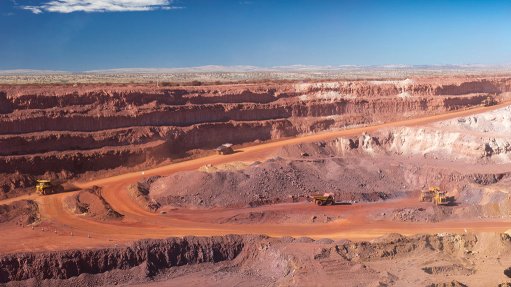
KEY ADVANTAGE Kumba’s key competitive advantage is its high lump production ratio of 68%
Diversified mining major Anglo American’s Kumba Iron Ore is dominating the local iron-ore sector, says research and consulting company Roskill.
Kumba’s 2018 iron-ore production was 43-million tonnes, with its Sishen mine accounting for 29-million tonnes and the Kolomela mine accounting for 14-million tonnes. Both mines are located in the Northern Cape.
Exports amounted to 40-million tonnes – 60% of which was destined for China – with the rest of Asia accounting for 20% and Europe for 12%.
Kumba’s key competitive advantage is its high lump production ratio of 68%. In 2018, Kumba’s share of premium products – lump with an iron content above 65%, and fines with an iron content above 64.5% – accounted for 30% of exports, says Roskill analyst Erik Sardain.
“Lump can be directly fed into the blast furnace in steel production, bypassing the sintering process. The stringent environmental measures implemented in China – combined with the relatively high margins enjoyed by the Chinese steel mills – contributed to a higher lump premium in 2018, averaging $0.25/t versus the $0.17/t in 2017,” he says.
The lump premium has hovered between $0.35 a dry metric ton unit and $0.40 a dry metric ton unit this year, before declining – the lump premium peaked in March and started declining afterwards – in line with lower margins.
However, Roskill believes that global environmental regulations and sintering constraints will keep the lump premium well above its historical standards – which is quite beneficial for Kumba, as its fines also have a high iron content.
“Kumba’s main weakness is its limited life-of-mine (LoM) – 20 years – and its limited capacity to significantly increase production. Therefore, Anglo American cannot take full advantage of the current tight market in terms of volume,” says Sardain.
He adds that Kumba plans to extend Sishen’s LoM through the Sishen lower-grade project, which could potentially increase production by another six-million tonnes a year using an advanced beneficiation technology from the lower-grade resources previously classified as waste.
The first phase – 1.7-million tonnes a year of production – is expected to start in 2019. Another production-increase opportunity would come from the Sishen dense-medium separation concentrate project, which is currently in the feasibility stage.
Sardain suggests that production from the project can be ramped up to 2.9-million tonnes a year by 2020 with treatment of the jig tailings.
Moreover, technology plays a more important role in the mining industry, especially at Kumba, through driverless trucks or centralised systems, which help to boost efficiency and profitability.
“Kumba is, thus, able to mitigate its logistical challenges by maximising the production of higher-quality, premium products.”